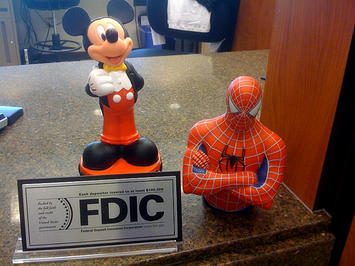
A travelling salesman is driving down a country road when he runs over a cat. Seeing a farmhouse nearby, he approaches to confess this unfortunate situation to the pet’s owner. When a woman answers the door, he says, “I’m sorry, but I think I just ran over your cat.” She asks him, “Well, what did it look like?” “Oh, m’am,” he replies, “I completely ran over it, so it was very awful, just a smear on the road…” “Oh, no,” she interrupts, “I mean, what did it look like before you ran over it.”
Congress and the Administration are trying to find ways to spend more money in their quest to stimulate the economy. But just like that travelling salesman, they are working with the picture after the wreck – and they can’t seem to focus on what things looked like before it happened. In other words, they are so happy to be spending money without restraint that they have neglected to figure out how we got into this mess in the first place. We all know that the problem started in the financial sector – I don’t know anyone who would disagree with that. In fact, the banks were the first to get money from the federal government – the October 3, 2008 act of Congress that will forever be known as The Bank Bailout.
Sadly nothing is different than it was on September 17, 2008 – the day that your 401k turned into a 201F. The now officially “to big to fail” banks are no more restrained in their activities today than they were in the days, weeks, months and years leading up to the crisis. If anything, they are a little freer because now they are all “banks” with a federal guarantee for ever more risk-taking behavior without consequences.
Becoming a bank means that the money they hold can be protected by the Federal Deposit Insurance Corporation (FDIC). The FDIC has been “so depleted by the epidemic of collapsing financial institutions” that analysts thought it would be forced to borrow money from the Treasury before the end of 2009. Since January 1, 2010, another 41 banks have failed. To hold the wolves at bay, the FDIC board eased the rules on buyers of failing banks, opening the door for hedge funds and private investors to gain access to “bank” status – and the protections that go with it. At the end of the third quarter of 2009, the FDIC’s fund was already negative by $8.2 billion, a decrease of 180 percent in just three months (from July to September 2009). According to the Chief Financial Officer’s report, the FDIC projects that the fund “will remain negative over the next several years” as they absorb some $75 billion in failure costs through the end of 2013. Taking their lead from Congress – that is a policy of robbing the future to pay off the past – the FDIC is proposing that banks pre-pay their insurance fees for the next three years.
There is no relief in sight, either. Just this week, a case of “insider trading” in New York was dismissed because the deal involved credit default swaps which – as I explained here last March – payoff losses “like” insurance but not regulated like insurance and which are bought and sold “like” securities but not regulated like securities. Although they are at the root of the causes of the financial crisis, not one new rule, regulation or law has been implemented to stop this nonsense from continuing. If you look at who’s in charge of figuring out what went wrong – and making recommendations on how to prevent it from happening again – you will find the Financial Crisis Inquiry Commission consists of political appointees who “have consulted for legal firms involved in lawsuits over the crisis.”
That’s not reassuring. A Commission composed of members who earn their livelihood from financial institutions – including those that precipitated the crisis – is unlikely to solve or have any incentive to discover the mystery of the causes of the greatest financial collapse in the history of the world. This group is part of the problem – not the solution.
Eighteen months after Wall Street roasted weenies on the bonfire of your 401k, the one noticeable difference is that the stock market is higher than it was on that fateful day in 2008. Unfortunately, this version of “economic recovery” is being driven by the financial services industry instead of the real economy. As rising stock prices encourage more savers and investors into the stock market, they create an increasing supply of investable funds in the hands of the banks – who remain as free to speed down our financial highways today as they were when they ran over the economy like that poor cat on a country road, leaving nothing but a stain on the pavement.
Susanne Trimbath, Ph.D. is CEO and Chief Economist of STP Advisory Services. Her training in finance and economics began with editing briefing documents for the Economic Research Department of the Federal Reserve Bank of San Francisco. She worked in operations at depository trust and clearing corporations in San Francisco and New York, including Depository Trust Company, a subsidiary of DTCC; formerly, she was a Senior Research Economist studying capital markets at the Milken Institute. Her PhD in economics is from New York University. In addition to teaching economics and finance at New York University and University of Southern California (Marshall School of Business), Trimbath is co-author of Beyond Junk Bonds: Expanding High Yield Markets.












